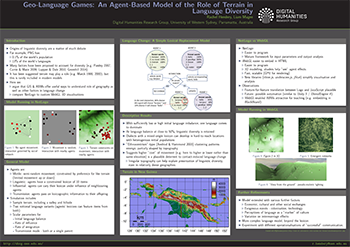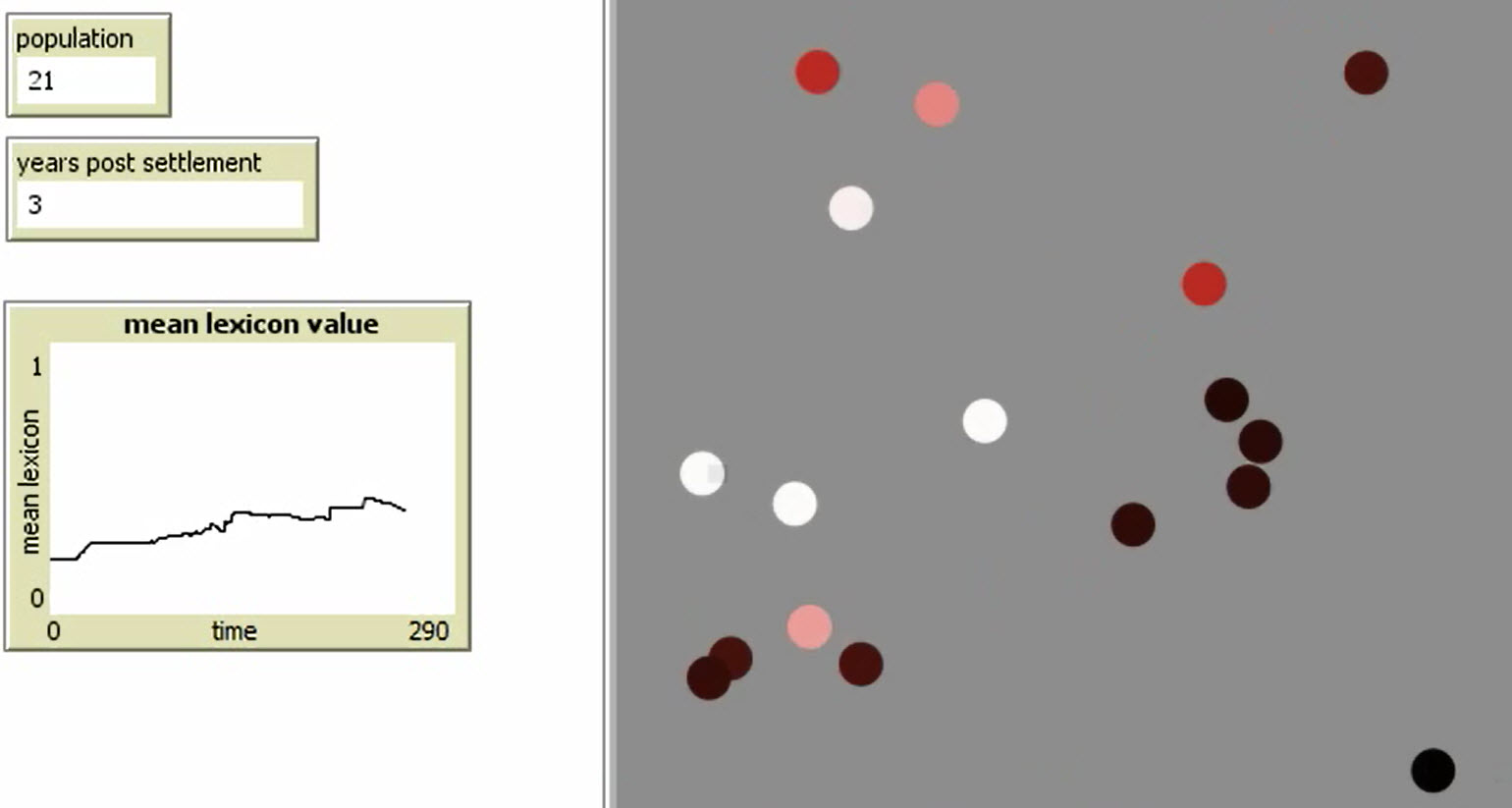- About Us
- People
-
Projects
- - Current Projects
-
- Past Projects
- - Book History Manuscripts
- - Mama and Papa in Indigenous Australia
- - Mapping Co-Lexification Patterns in Sahul
- - Palmerston Island Social Networks, Linguistic Variation and Language Change
- - Mapping Currents of Change and Exchange in the Pacific
- - Aboriginal Dreaming
- - Uruk 3000 BC
- - At the Heart of It
- - Music, Mobile Phones and Community Justice in Melanesia
- - Geo-language Games
- - Journal Finder
- - Migration, Mobility and Connection
- - Digital Lives and Archives of Irish Literature and History
- - Just Spaces
- - Digital Visualization: Ming and Qing Buddha Statues in the Hunan Region
- - ARCHivER
- - Waves of Words
- Events and Seminars
Geo-language Games
Agent-based modelling of language change
Rachel Hendery (DHRG) and Liam Magee (DHRG, ICS)
Agent-based models assume one or more computer-based autonomous, linguistic, reactive, proactive and intentional agents who interact with each other and their environment. Given an initial set of states distributed across a group of agents, and a finite set of rules, these interactions can then show interesting emergent patterns over time. Agent-based models can be useful as much for their explanatory as for their predictive value – as sorts of "thought experiments" for elucidating how complex phenomena might emerge from simple assumptions. Increasingly, ABMs have been applied to social phenomena such as economic systems (Farmer and Foley 2009), political cooperation and decision-making (Axelrod 1997), urban development (Batty 2007), social networks (Macy and Willer 2002) – and language change (Steels 1997).
However, agent-based modelling remains an under explored – if tantalising – approach to understanding models of language change. As one example, Parkvall et al (2013) proposed an agent-based model for the evolution of creoles in which agents follow extremely simple rules about talking to each other and updating their lexicon to 'learn' new words from each other during interactions. They tested this model for various combinations of founder languages, and found that it successfully predicts the lexifier language in the resulting creole.
The idea behind such a simulation is not to include all possible factors in language change, but to pare them down to the minimum needed to get a realistic outcome. This shows us which elements are most important in language change. Elements that have been considered in previous agent-based simulation of language change include social networks, genetic predisposition of the agents to language learning, and diversity of founding population, but to our knowledge, no one has included geographical factors.
In a poster at DH2015 conference in Sydney we presented a model of language change in two sample regions: Palmerston Island (Cook Islands) and a range of terrain types in Papua New Guinea using a GIS-based agent-based model. In the first case the terrain is extremely flat, with no rivers or other potential obstacles to divide groups. The only terrain effects that could affect language change are the relative density of bushland that makes certain paths across the island easier to traverse than other. People are therefore more likely to encounter those who live near those paths than those who live in the denser bushland. In Papua New Guinea, on the other hand, we consider hilly terrain, rivers and swampland as well as bush, so that population movement is much more constrained. We argued that relatively simple ABMs can represent complex emergent patterns typical of language differentiation among these relatively geographically proximate groups.
We build upon existing work with a web-based ABM framework, Fierce Planet (Magee 2012; Magee 2014). The affordance of this framework over more established ABM frameworks such as NetLogo, Repast and CORMAS is the relative accessibility of simulations – these can be easily deployed and shared with other researchers and communities. We adapt that framework for three-dimensional rendering using WebGL and Three.js, and import geographical models for both locations. For Papua New Guinea, we import DEM models developed by USGS. For Palmerston Island we construct a DEM model using World Machine since it is too small and low-lying to be picked up satellite.
Click here to view a simple netlogo-based model for random movement-based encounters of speakers of two languages (white and black) who learn each other's lexicon over time. Red represents bilingualism. You can also download more information about Geo-Language Games: An Agent-Based Model of the Role of Terrain in Language Diverstiy.
References
- Axelrod, R. M. (1997). The complexity of cooperation: Agent-based models of competition and collaboration. Princeton University Press.
- Batty, M. (2007). Cities and Complexity: Understanding cities with cellular automata, agent-based models, and fractals. Cambridge MA: The MIT Press.
- Farmer, J. D., & Foley, D. (2009). The economy needs agent-based modelling. Nature, 460 (7256), 685-686.
- Gilbert, N., & Troitzsch, K. (2005). Simulation for the social scientist. McGraw-Hill International.
- Macy, M. W., & Willer, R. (2002). From factors to actors: Computational sociology and agent-based modeling. Annual review of sociology, 143-166.
- Magee, L. (2012). Simulating a'fierce planet': a web-based agent platform and sustainability game. In Proceedings of the 2012 SpringSim Poster & Work-In-Progress Track (p. 9). Society for Computer Simulation International.
- Magee, L. (2014) "Fierce Planet: Sustainability Priming through Online Gaming and Simulation". Proceedings of SimTecT, Adelaide, 2014.
- Parkvall, M., Jansson, F., & Strimling, P. (2013). Simulating the genesis of Mauritian. Acta Linguistica Hafniensia, 45(2), 265-273.
- Steels, L. (1997). The synthetic modeling of language origins. Evolution of communication, 1(1), 1-34.
- Troutman, Celina; Clark, Brady; and Goldrick, Matthew (2008) "Social networks and intraspeaker variation during periods of language change," University of Pennsylvania Working Papers in Linguistics: Vol. 14: Issue 1, Article 25
Mobile options:


